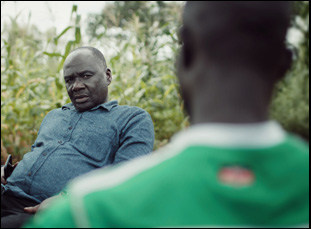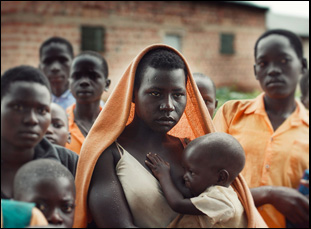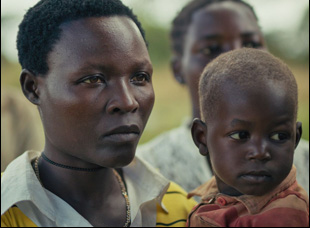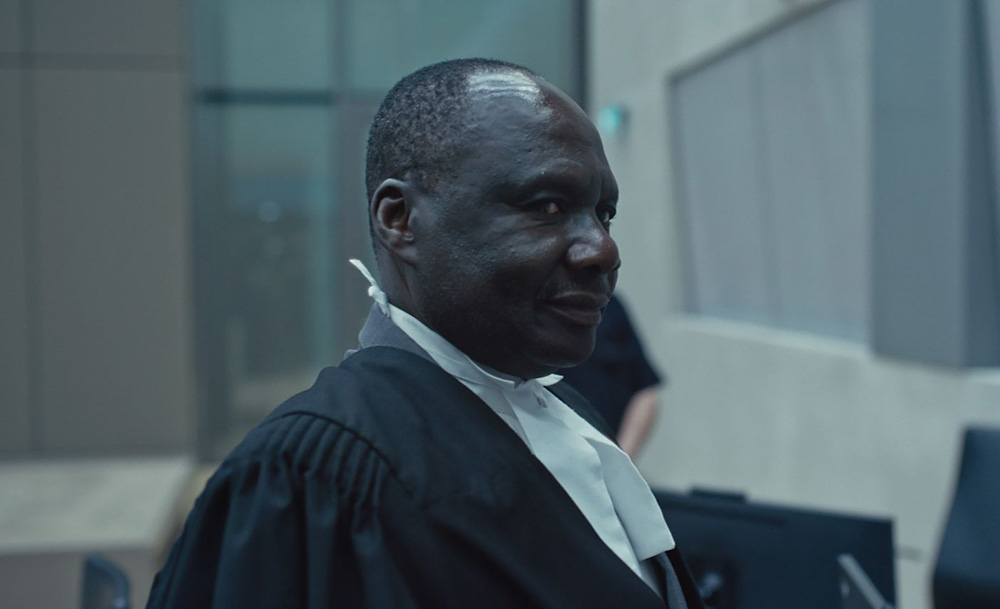In his opening statement to the International Criminal Court, Dominic Ongwen says he’s “happy” to have been brought before the body, surprising words when he stands trial for his role in war crimes as part of the Lord’s Resistance Army, the resistance movement that rose against the Ugandan strongman Yoweri Museveni, who hasn’t ceded power since taking over the presidency in 1986. The prepared remarks can can be interpreted as a taunt or as a statement of genuine anger as he says standing in the Hague gives him the feeling of being “abducted back into the bush again,” but there is also a sense of tragic inevitability when he describes the place the court holds in the imagination of Ugandans as a final destination, spoken about as one would about the afterlife where all one can do is surrender to it and there may be as much relief as anguish when the burden of enduring the day-to-day reality in the region is alleviated.
If the court itself can represent all these things to Ongwen, it seems only fair for co-directors Emil Langballe and Lukasz Konopa to broaden ideas about where he’s coming from in “Theatre of Violence,” which sees Ongwen’s defense lawyer Krispus Ayena return back to his client’s former home of Gulu in Northern Uganda as the trial wears on to learn more about the circumstances that led to becoming a top commander for the LRA, responsible for the deaths and abductions of thousands. While LRA leader Joseph Kony claims to have been called by God to rise against Museveni, a notoriously corrupt head of state who preserves his authority with military might, Ongwen was among the first generation of impressionable youths to be enlisted by Kony as a child soldier in the LRA’s cause, complicating the case against him when Ayena plans to argue before the court that while Ongwen can’t dispute the claims against him on factual grounds yet that he is a perpetrator only because he was a victim of the very same crimes he’s accused of committing now.
Simply by appearing in court, Ongwen’s personal fate seems sealed, yet “Theatre of Violence” opens up the case to the far greater implications it could have as generations of Ugandans are caught in a cycle of violence unlikely to end any time soon, with Langballe and Konopa conscious of the most successful recent political campaign to unseat Museveni when he’s challenged by the popular musician Bobi Wine still falling short occurring in the background of their visits to Gulu as it plays out on the local news. But instead of envisioning witnesses that take the stand in Ongwen’s trial as only having a role in the case, the co-directors look to their lives outside of it as Ayena and his team do discovery, evoking the kind of climate Ongwen grew up in and the types of attitudes in the community that shaped him. Following Ayena’s lead, the filmmakers’ approach to the case is unconventional but effective, using the vast skies above Africa where the range of opinions and realm of possibilities seem wide open in stark contrast to the cloistered courtroom in the Netherlands where notions of justice appear too rigid a response to what’s going on a continent away.
After recently premiering at CPH:DOX, “Theatre of Violence” is making its way to North America with bows this week at Hot Docs in Toronto and in June in New York as the centerpiece screening of the Human Rights Watch Film Festival and Langballe and Konopa spoke about how they were able to take such a dynamic look at the international justice system, the appeal of Ongwen’s case as a way in and considering the kinds of imagery that one normally associates with conflict zones in giving an audience an entirely new way to see the situation.

Emil Langballe: We went to film school together in the UK, and we always hung out and shared similar ideas about documentaries and talked about working together. Later, we were working on individual projects in Uganda, and we both heard about the trial [when] it had just been announced in 2016. We got really fascinated by Dominic Ongwen, and his role as a victim and as a perpetrator and all the implications of the trial.
Lukasz Konopa: We started by contacting the the lawyers of Dominic Ongwen, and that was the beginning of our journey that lasted for almost six years.
What was it like to find your way into the story? You avoid traditional sit-down interviews.
Lukasz Konopa: We knew that the narrative spine of the film would be the trial, so we were building the film around that and we knew we wouldn’t have access to Ongwen himself because he was in the ICC penitentiary, so therefore we had to find another person who could tell the story. After we met Mr. Ayena, his lawyer, we became quite intrigued by the aspect of him being our guide in the film to take us to Uganda and follow his quest to piece together how did Ongwen transform from an innocent child into a perpetrator. And the next step was to get in touch with the court and the prosecution team.
Emil Langballe: And when we first went to Uganda, we were struck by this big contrast between this very wild and lively and beautiful place that Uganda is where people now co-exist peacefully, even though it’s not so long ago since there has been this conflict, and then this ICC building in The Hague that was very sterile and very bureaucratic. We were very interested by this contrast and we thought a lot about what a guy like Dominic Ongwen would think being parachuted into that atmosphere, and also what people in Uganda were thinking about the Hague and the whole persecution of one of their community members.
Lukasz Konopa: There is also this maybe not realistic layer of the film — this slow motion travelling shot [we use in Uganda] because we didn’t want to show archival [footage] from the conflict, but we wanted to convey the atmosphere of terror or brutal indoctrination that Dominic went through, so we developed this more visual experimental layer with that footage together with Dominic Ongwen’s own voice. We didn’t want to have this shock value of the brutal [footage] that has been shown so many times in Western media, but we wanted like a more suggestive layer where people could think for themselves and connect the the dots.

Emil Langballe: Yeah, they were actually interwoven because the trial was split up, so Krispus would go on these trips in between, so every time we went to Uganda, we came back with new perspectives and new ideas, and then we could watch the ongoing trial in a new light and vice versa.
Lukasz Konopa: Yes, between each trip, we had a couple of weeks of editing, which was really crucial in our process because we could just see what works and what doesn’t and we could focus more on specific storyline in our next trip. At the same time, we were together with our assistant going through court footage and transcripts — we were provided with almost 40,000 pages of just court transcripts, and among these pages, we were trying to find these emotional moments or interesting witnesses and then we could go back to Uganda and meet these witnesses in person. Sometimes we would meet them before they came to the Hague and sometimes we would meet them after we’ve seen them in the trial.
Emil Langballe: We also wanted to see the contrast from how they are behaving in Uganda and what happens when they’re suddenly put on the stand in the Hague in a suit and how do they express themselves. Of course, it was a huge and challenging task to somehow get an overview of all the central actors and somehow also finding a structure that would work because before we started editing, we didn’t know if it would work jumping back and forth between Uganda and the trial so freely as we actually do and if people would remember the witnesses that would come back on trial and meet them in Uganda. That’s why it was really crucial that we also had these blocks of editing between the trips so we could know if we were on the right path.
Lukasz Konopa: Traveling in between was really crucial to this process. Thematically, we started out by being mostly interested in the victim/perpetrator aspect. But after more and more trips to Uganda, more and more layers would reveal themselves and we learned about the struggle of the Acholi people, about the oppression by the government and the current election that was taking place similar at the same time with the trial, so we never knew where we were going to end and it was a very complex and interesting journey for the both of us.
Was there any direction this took you may have been surprised by?
Emil Langballe: Yeah, it was very interesting for us when we at the ICC, they do this outreach event where they go to the affected communities and they screen the trial, as you see in the film, and when we came to those, I think we had expected that the people there would be very critical of Ongwen because those were like his victims or families of the victims. But in fact, most of the time they were asking why the government was not held accountable for the atrocities that they were part of or had part in, so that started to change our perspective or broaden it a little bit. One of our questions that we set out to ask [was] are we born with an inherent moral compass? Nurture versus nature…
Lukasz Konopa: But then the more we learn about the conflict, the more we realize that we have to also give platform to stories of Northern Ugandans about the role of the government in this whole conflict that was very important. Then of course, different types of justice — retributive justice versus restorative justice — became also crucial at some point.
Emil Langballe: One of my favorite cuts in the film is when this woman Rosalba [Oywa, a peace activist] speaks about the different types of justices — retributive justice of the West and the restorative justice that she is an advocate for in Uganda. And then we cut to some of the lawyers of the prosecution talking about a comma. These kind of ideas were very interesting to explore both shooting and editing.

Lukasz Konopa: In general, access was challenging because we are dealing with court case and lawyers and prosecutors, but eventually we were given access to some of these meetings under the condition that we will not release the film before the final appeal judgment.
Emil Langballe: Yeah, but because many of the people working on the prosecution side, they don’t only work on the Ongwen case but they have careers within the ICC, so they would be quite careful in terms of what they would say and do and what we could film. Shooting within the ICC building was extremely difficult. We could not really turn the camera on in the hallway without many different things having to be cleared, so it was the most difficult shooting conditions that we’ve ever tried. Basically, what we managed to shot with the prosecutor, almost everything we ever shot, we put in the film.
After six years, what’s it been like to get out into the world?
Emil Langballe: Yeah, it’s cathartic and very fulfilling to suddenly see it on the big screen. We had the premiere in Copenhagen not so long ago and then Krispus Ayena flew in from Uganda and had a Q&A with us after the screening. And he could like elaborate with anecdotes from his time working with Ongwen and also being a facilitator in the peace talks in Uganda. Everything just came together, and it was a really touching and nice experience.
Lukasz Konopa: And we are planning to show the film in Uganda, so that will be another step. We are trying to find out if it’s possible and [we would like] to screen it as close as possible [soon] — in this case Kenya — but we would like to share this film with people of northern Uganda.
“Theatre of Violence” will screen at Hot Docs on May 2nd at Scotiabank Theatre 7 at 5:30 pm and May 6th at the Scotiabank Theater 6 at 11:15 am.




